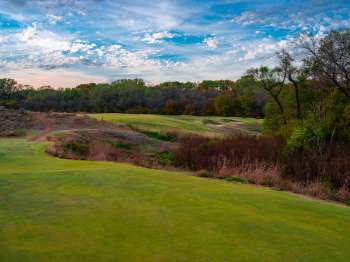For a number of reasons, the Trinity Forest golf course had no business being featured in a book like this (Planet Golf USA Vol 2). For a start, club founders based a large part of their pitch to use council land on the return of PGA Tour golf after a long absence. They then hired a design team arguably less interested in building tournament ready golf courses than any other, and presented them with the worst piece of ground in their distinguished careers. Somehow it worked, and Trinity Forest stands today as perhaps the finest modern golf course in urban America.
-- This course review of Trinity Forest appears in the new edition of Planet Golf USA (2020) --
The back-story of this club is fascinating, and should warm the hearts of true golf environmentalists everywhere. Less than 10 miles from downtown Dallas, the course was built within the Great Trinity Forest, but upon a toxic landfill site that was set to cost the City $12 million to remediate. Sensing the opportunity for creative public / private collaboration, an initiative was formed to lease the land for golf and then raise money to both rehabilitate the area and create a high-end, tournament-caliber golf club. The Trinity Forest Golf Club was formed, and Bill Coore and Ben Crenshaw engaged to design its course.
Coore and Crenshaw would ordinarily avoid such sites, but this one was close to home and the rippled contours of the landfill were surprisingly workable. The challenge intrigued them. The entire property was capped and the landforms beneath essentially recreated in topsoil and sand. Endangered prairie plantings were successfully reintroduced to out-of-play areas, enabling Coore and Crenshaw to design and construct holes in a traditional manner, and from what appears a mature, meadow type ecosystem.
As positive as the conservation outcomes here have been, it’s the design that steals the show. Bordered by the hardwood forest, each of the nines display tremendous balance and consistency as they continually change orientation and hop either side of an interior ravine. Aside from the short 8th, which like the 9th at Cabot Cliffs is wedged somewhat uncomfortably between longer holes, the routing has a beautiful rhythm and an uncluttered elegance, owing to its open, windswept character and lack of rough. Both the greens and bunkers range enormously in size but dominate the landscape no matter how they are used or where they are positioned. As memorable as the 30,000 square foot double green at the 3rd and 11th, for example, is a small, Pinehurst-esque target at the 5th hole, which looks straightforward but is domed to fall away on all sides.
There is much to admire individually about the holes at Trinity, in particular the variety and strength of the longer par threes, the shorter par fours and elastic par fives like the 1st and the wonderful 7th. Approach play is fascinating from start to finish, and all about angles and the degree of risk taken from the tee. The middle of the fairway can certainly work here, but only if the golfer is comfortable with an awkward approach angle. Finding advantageous slopes into pinable areas is crucial and takes careful study and experience. Importantly, most of the shots can be appreciated by any standard of player. Though the climate and zoysia turf surfaces prevent year-round bounce and firmness, the designers deserve credit for sticking to their traditional design values and philosophies, and somehow fashioning a course that is as engaging for regular amateurs as it is for the professionals who visit once a year.
From inauspicious beginnings, Trinity Forest provides yet further evidence of the good that our game can do socially, environmentally and economically. All credit to the founders of this fine club, for a tremendous conservation success story, and an equally impressive golf experience.

 this course also has exceptional:
this course also has exceptional:
